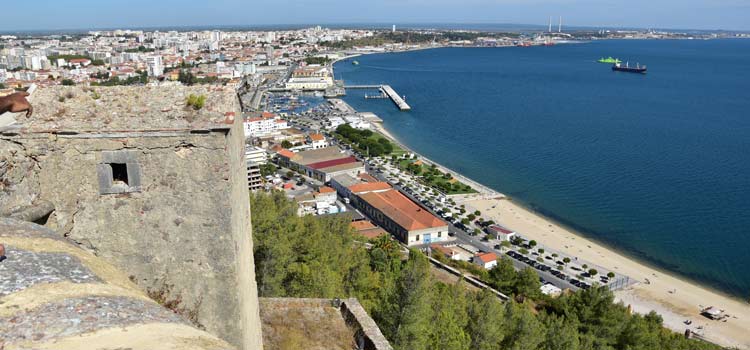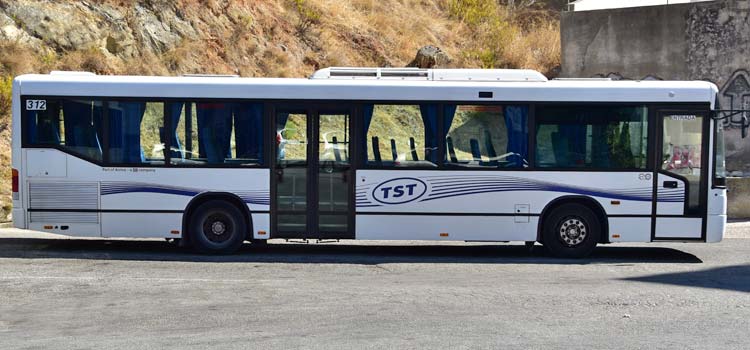SintraCascaisSesimbra.com
The best independent guide to Sesimbra
SintraCascaisSesimbra.com
The best independent guide to Sesimbra
Sesimbra to Setubal by bus
Sesimbra and Setubal are two fascinating but wildly different tourist destinations; Sesimbra is a charming resort town, which is adored by the Portuguese, while Setubal is a much larger fishing and industrial port.
Hidden beneath the gritty and tough exterior of Setubal is a historic town with a surprising amount to captivate visitors, and is the main access to the paradise beaches of Tróia Peninsula.
Often visitors spend a holiday in Sesimbra and take a day trip to Setubal, but equally, Setubal is a great destination for tourists who are after a raw, non-manicured Portuguese experience.
This article will detail how to travel from Sesimbra to Setubal and provides a guide to the bus service along with useful tourist information.
Related articles: Setubal guide - Sesimbra guide

The view over Setubal from the castle
Setubal to Sesimbra bus
Setubal is 20km to the east of Sesimbra and the towns are separated by the beautiful hills of the Parque Natural da Arrábida. The only option for public transport between the two is by bus, which unfortunately does not even pass through the Serra da Arrábida.
The Lisbon to Sesimbra bus service is operated by T.S.T (Transportes Sul do Tejo, a DB bus company) and is the 230 route. This is a surprisingly limited bus service.
During the working week, there are ten daily departures, but this drops to just four at the weekends and severely limits a day trip. The latest timetable is displayed in both bus stations, and can be seen on the Carris Metropolitana website:carrismetropolitana.pt
A single ticket costs €3.30 and is purchased from the bus driver on boarding the bus. These local bus tickets cannot be bought from the ticket office in Setubal bus station.

The bus service is operated by Carris Metropolitana
The bus journey takes just under an hour but unfortunately does not follow the beautiful coastline and skirts the edge of the Parque Natural da Arrábida. From Sesimbra, the bus heads north to the village of Santana then along the N379 to Azeitão (centre for wine production, see details later on).
At Azeitão the bus joins the major N10 and cuts south-east to Setubal. The 230 bus service does not cover any of the beaches of the Serra da Arrábida, and public transport to them is very poor, so may be worth considering a rental car.
Setubal and Sesimbra bus stations
The 230 bus service departs from Setubal bus station, which is on the Avenida 5 de Outubro, in central Setubal (GPS: 38.52537, -8.88921). Setubal bus station is a grim and dated complex, which overdoes the concrete effect, luckily there are cafes outside.
The actual departure location of the Sesimbra bus may be outside, as the bus bays are given preference to the intercity services. Always check the display board to confirm the exact departure location.
Setubal is a major regional bus station and from here there are buses to many major cities of Portugal including the Algarve and the Alentejo region.
Sesimbra bus station is much smaller than Setubal and is an open-air bus station with a few bus bays. Sesimbra bus station is located on the main Avenida da Liberdade road, approximately 350m from the beach, (GPS: 38.44580, -9.09983).
Sesimbra does not have the same number of intercity buses as Setubal and most bus departures are local or to Lisbon. For onward bus travel to the rest of Portugal it may be more convenient to head to Setubal or Lisbon.

Sesimbra bus station is pretty basic
Azeitão
An interesting stop along the route is the town of Azeitão. This town is at the heart of the Setubal wine producing region and within walking distance are two wineries; the historic José Maria Da Fonseca and the larger Bacalhôa Vinhos. Both provide wine tasting and tours of their facilities, a great detour!
Our most popular guides to the Sesimbra region















